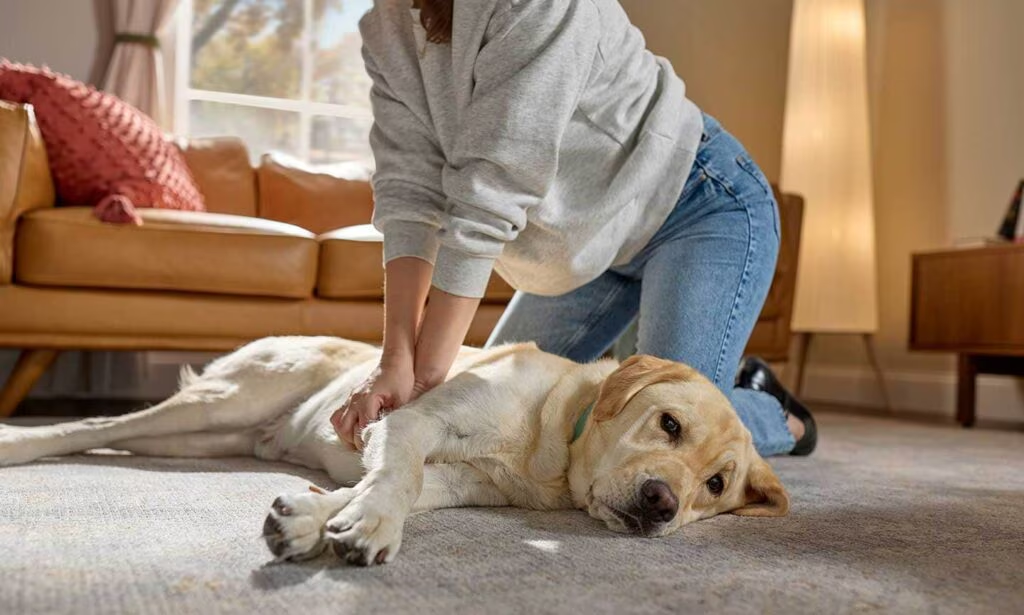Introduction: Why Dog CPR Certification is Essential
Dogs are loyal companions, but emergencies can happen suddenly—choking, cardiac arrest, poisoning, or trauma. Knowing how to perform CPR on your dog can literally be a lifesaver.
Dog CPR and First Aid Certification equips pet owners with practical, hands-on skills to respond quickly and effectively. Online certification through CPR Certification Now makes this training accessible, convenient, and comprehensive.
Pro Tip: Even a basic understanding of dog CPR can make a life-saving difference before veterinary care is available.
Step 1: Assess the Situation
Before performing CPR:
- Ensure Safety: Make sure the environment is safe for you and your dog.
- Check Responsiveness: Gently shake or call your dog to see if they respond.
- Call for Help: If possible, have someone contact a veterinarian or emergency animal hospital immediately.
Tip: Do not delay CPR if your dog is unresponsive or not breathing—every second counts.
Step 2: Position Your Dog Correctly
- Lay on Side: Place your dog on a firm surface on their right side.
- Legs Straight: Ensure the legs are extended naturally to avoid strain.
- Clear Airways: Open the mouth and ensure there are no obstructions in the throat.
Callout Tip: For small dogs, you can perform CPR on your lap; for larger dogs, use the floor.
Step 3: Perform Chest Compressions
Locate the Correct Spot
- For medium to large dogs: compress the widest part of the chest (heart area).
- For small dogs: compress just behind the elbow on the chest wall.
Compression Technique
- Use one or both hands depending on the dog’s size.
- Compress 1/3 to 1/2 the width of the chest.
- Rhythm: 100–120 compressions per minute (similar to human CPR).
Tip: Allow the chest to fully recoil between compressions to maximize blood circulation.
Step 4: Rescue Breathing
- Seal the Mouth: Close the dog’s mouth gently.
- Cover Nose: Place your mouth over the dog’s nose.
- Give Breaths: Blow air steadily for 1 second, watching the chest rise.
- Ratio: Two breaths after every 30 chest compressions for adult dogs.
Callout Tip: For very small dogs or puppies, use gentle puffs of air to avoid lung injury.
Step 5: Repeat Cycles Until Help Arrives
- Continue cycles of 30 compressions and 2 breaths.
- Monitor for signs of breathing, coughing, or movement.
- Stay calm and consistent until veterinary assistance is available.
Pro Tip: If alone, perform CPR for 2 minutes, then quickly call the vet while continuing cycles.
Additional Tips for Dog CPR Success
- Practice Regularly: Certification courses provide mannequins or simulations for safe practice.
- Know Your Dog’s Normal Signs: Understanding breathing and pulse can help you assess emergencies faster.
- Stay Calm: Panic reduces effectiveness; focus on rhythm and technique.
- Transport Carefully: If moving your dog to a vet, maintain chest compressions if needed.
Benefits of Getting Certified Online
- Flexible Learning: Study at your own pace without leaving home
- Interactive Modules: Videos and simulations demonstrate correct CPR technique
- Instant Certification: Digital certificates are issued upon completion
- Affordable & Accessible: Avoid travel and in-person training costs
Pro Tip: Online certification courses often include emergency scenario training, enhancing your real-life preparedness.
Who Should Take Dog CPR Certification?
- Pet owners of dogs of any size or breed
- Veterinary assistants and technicians
- Dog trainers, groomers, and boarding staff
- Rescue volunteers or shelter workers
Pro Tip: Even if you own one dog, certification ensures you are ready for unexpected emergencies at home or in public spaces.
Course Timeline and Cost
Timeline
- Registration: 5–10 minutes
- Course Completion: 2–3 hours
- Assessment & Certification: 30–45 minutes
- Digital Certificate Issuance: Immediate
Cost
- Basic Online Course: $30–$60
- Comprehensive Packages: $60–$100
- Optional In-Person Workshops: $75–$150
Tip: Online courses are cost-effective and allow completion in one day.
Renewal and Refresher Training
- Certification is typically valid for 2 years.
- Refresher courses ensure you maintain proper technique and stay updated with the latest first aid practices.
Pro Tip: Schedule renewal before expiration to maintain preparedness.
Frequently Asked Questions (FAQs)
- Can I perform CPR on any dog breed?
Yes, techniques are adjusted for size, from small breeds to large dogs. - Do I need prior experience with dogs?
No, courses are suitable for beginners and professionals alike. - How long does online dog CPR certification take?
Typically 2–3 hours. - Will online certification be recognized professionally?
Yes, accredited courses are accepted by employers and veterinary professionals. - Does the course include practical exercises?
Yes, online simulations and interactive videos provide safe hands-on practice. - How often should I renew certification?
Every 2 years or as updated modules are released.
Conclusion: Be Prepared to Save Your Dog’s Life
Emergencies can happen without warning, but knowing how to perform CPR on your dog can make all the difference. Certification equips pet owners and professionals with life-saving knowledge, confidence, and practical skills.
With online certification from CPR Certification Now, you can complete the course efficiently, gain essential skills, and receive instant recognition.

